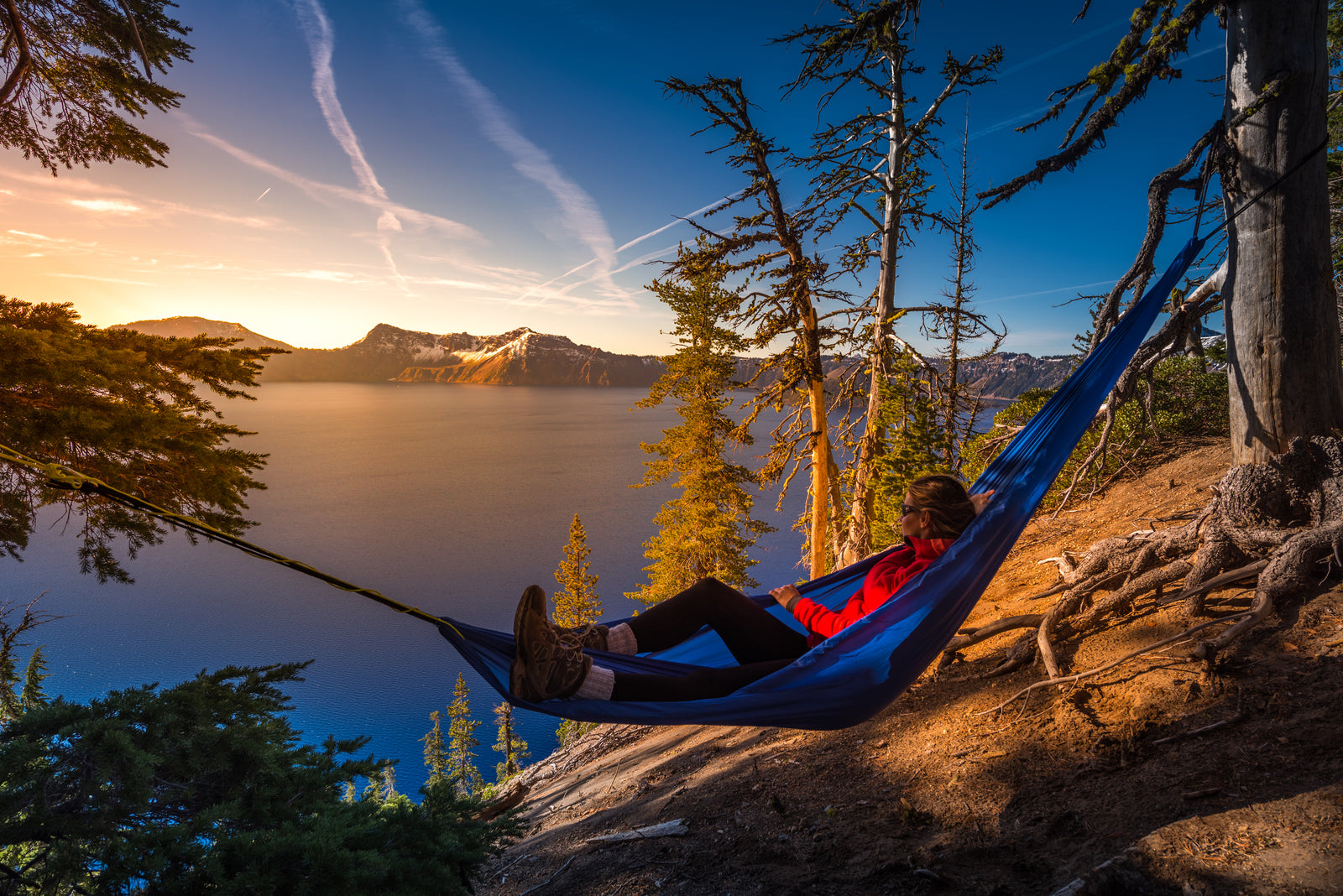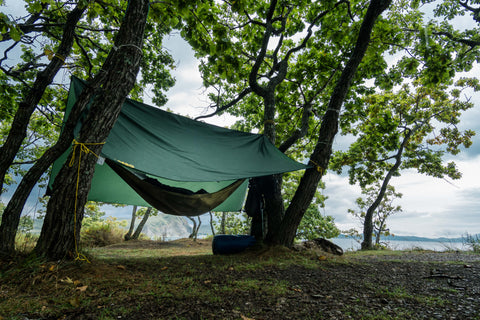Your Cart is Empty

Before you get ready to start planning out your next—or first—backpacking or thru-hiking trip, you might be wondering if you’ve got the right gear and how you might set up camp. It’s likely you’ve heard people talk about hammock camping, and, of course, seen tons of zenned out adventurers sitting in hammocks on social media. But, is hammock camping really a worthy experience? And, if so, (spoiler: we say it definitely is) how do you hammock camp in a way that’s both good for you and good for nature?
Read our comprehensive guide to learn how to hammock camp like a pro!
In this article, you’ll learn:
Let’s get started!
Hammock camping—sleeping in a nylon sling between two trees—is growing in popularity with backpackers and people who like to travel “ultralight.” Hikers favor their low weight, compactness and their small footprint. Others appreciate the comfort and simplicity of hammock camping. Over the last few years, this method of camping has skyrocketed in popularity and is preferred by thousands of nature and adventure lovers all over the world.

For a successful night of hammock camping, you’ll want to have this gear in your pack:
Try to find a hammock that will fit your body well. Hammocks are pretty uniform in size; you can find them in one- or two-person sizes. The two-person sizes are about a foot wider and 1-2 feet longer. Typically, a two-person hammock will be more comfortable to sleep in, but you’ll be adding weight to your pack.
That weight difference is typically just a few ounces so it likely won’t be very noticeable, though, unless you’re on a pretty serious backpacking trip. So, there’s really no harm in getting that two-person hammock for extra comfort.
Particularly if you’re someone who’s on the taller or heavier side, you’ll want to have a two-person hammock. You’ll never regret the added legroom or the extra support. However, most hammocks will hold at least 300 pounds, save for some ultralight models that have a 200-pound limit. So, choosing a hammock really isn’t too difficult—you’re free to pick the one you want!
Another important hammock specification to pay attention to is the “denier.” This is a unit of measurement that denotes the strength and thickness of fabrics, which, in the case of a hammock, is nylon. The higher the denier, the stronger (and heavier) the fabric. If you’re putting together an ultralight pack, look for a hammock in the 30-40D range to save weight. But remember: lower-denier fabrics will wear out faster.
There are two reasons to invest in tree straps to set up your hammock rather than use rope: convenience and conservation. Most hammocks come with a nylon cord, but they can be a pain to use.
More importantly, they’re also very thin and likely to damage tree bark. This can be a problem, especially if you’re camping in a park with protected wildlife. Some parks actually require hammock campers to use tree straps that are at least 2 inches wide. This spreads out the pressure the hammock puts on the bark, protecting the trees.
If you’re going to camp with a hammock, invest in a good set of tree straps. Besides being kind to the trees, they’re easy to use and very strong (most are rated above 700 pounds). Plus, most tree straps are pretty affordable, and they weigh less than a pound, so there’s no reason not to pack them.
The biggest drawback when sleeping in a hammock is that, by themselves, they do virtually nothing for you in terms of warmth. The fabric is simply too thin to keep you from freezing in the middle of the night. So, if you’re planning on hammock camping in temperatures that’ll dip below 60 F (which is pretty likely) you’ll want some extra protection.
Regular sleeping bags are one option—they can fit well enough in a hammock that you’ll be able to sleep through the night. But since the space is pretty limited, you may feel cramped. The best way to stay warm while hammock camping is by using a hammock-compatible sleeping bag, sometimes called underquilts.
Hammock-compatible sleeping bags slip over the outside of the hammock, like a thick, warm glove. They give you enough room to stretch out your legs and provide enough warmth to sleep comfortably through the night. If you’re planning on doing any sort of hammock camping, this is a must-have on your packing list. Plus, they’re small enough that they can fit into most backpacks or stuff sacks. Check out our stuff sack size guide to learn more!
Ridgelines are a helpful part of hammock set up, so pack a length of nylon cord that’s at least twice as long as your hammock. That’ll give you plenty of length to tie the cord above you. The ridgeline is used to set up your rain fly and bug net and to hang a gear bag. Any strong paracord, nylon cord, or rope will do; don’t worry too much about what your ridgeline is made of. It’s just important that you have it!
It might seem romantic to hammock camp while looking up at the stars, but practically, it’s not the best idea in most places you’ll likely be hunkered down for the night. So, you’ll need a rain fly (also called a rain tarp) to have a complete, comfortable hammock camping setup. Just place the rain fly over your ridgeline and stake it to the ground. This protects you from rain, wind, and unwanted moonlight or sunlight, so you can sleep peacefully.
While not quite as essential as a rain fly, having a bug net is a nice-to-have item that you’ll rarely regret not having on a backpacking trip. They’re standard in tents, so they should be standard in your hammock camping gear, as well. Plus, most bug nets for hammocks are pretty light, so you don’t have to worry about weighing yourself down.
The following items aren’t truly necessary for hammock camping, but they’ll come in handy. It’s up to your discretion whether or not you bring them—it will be important to weigh the pros and cons of added weight, usefulness, etc.
Now that you’ve got all the essential gear and you’ve set out on your hammock camping adventure, it’s time to set up camp!

Find a pair of trees with trunks that are at least 8 inches in diameter. Most trees with 6-inch trunks will be strong enough to hold you, but it’s wise to go for a thicker tree whenever possible. You’ll lower the risk of damaging the tree, which is always a good idea.
Ideally, the distance between each tree should be about four feet longer than the length of your hammock. That’ll give you enough room to set up the hammock at a good angle and height.
While the basics of hammock setup are quite intuitive, be careful not to fall into common setup mistakes. Most importantly, to get the best night’s sleep, you don’t want your hammock to be tied up too tight.
Rather, you should aim to get nice, 30-degree angles that go from the tree to the bottom of the hammock when you sit in it. This can take some guesswork, as you’ll have to set up the hammock, get in and judge the angle, and then try again if it isn’t right. It’s worth the effort, though. Getting this right will allow you to sleep in the most comfortable position possible.
One last consideration for optimal hammock placement: when sitting or laying in the hammock, you’ll want it to be about 18 inches off the ground. Any higher and you’ll have a pretty tough time getting in and out—especially in the middle of the night.
Next, you’ll want to get your hammock-compatible sleeping bag set up. To do this, simply unhook one end of the hammock from the straps. Your sleeping bag will slide on over the hammock, almost like a mitten. Then, reattach the hammock to the strap.
Adjust the sleeping bag or underquilt until it fits just right. You’ll want to get in the hammock to test the fit and make sure the opening for your head is in the right place. It won’t be difficult, but it’s better to take care of this step early, rather than wait until it’s bedtime.
Tie the ridgeline securely to each tree, making sure not to make it too tight. Remember that you won’t be putting very much weight on the ridgeline and that tying the rope too tight can damage the tree bark. If you like, you can tie the ridgeline directly onto your hammock straps instead of the tree. This helps you avoid damaging the tree, and it makes for a simpler overall setup. However, the ridgeline may be too low for your preferences.
A word about ridgeline height: you’re free to tie the ridgeline as high above the hammock as you like. Remember, though, that the higher the ridgeline, the more exposed you’ll be to wind and blowing rain. So, it’s a best practice to tie the ridgeline between two and three feet above the hammock itself.
Next up is your rain fly. Attach it to the ridgeline and stake it to the ground at roughly a 30-degree angle. You want the rain fly or tarp to be tight enough to resist strong winds, but again, not so tight that it could damage the tree. Make sure it’s centered over the hammock; the last thing you want is to wake up during a midnight storm soaking wet.
If you’re using a bug net, and you should be, it goes on last. Your bug net will come with its own set of instructions, so it’s best to follow them for proper setup.

Keep the following tips in mind for the best hammock camping experience possible.
“Leave No Trace” is an ethos that any camper, backpacker, and thru-hiker should follow when enjoying nature. Essentially, it means that you leave the areas you explore exactly as you found them. Follow these general guidelines to have an ethical and environmentally-responsible hammock camp setup:
Strange as it may seem, this simple trick can drastically improve the quality of your sleep. When laying in your hammock, angle yourself so your head is slightly to the right while your feet are slightly to the left, or vice versa.
Doing this will shift the way your weight is balanced and the tension in the hammock, which will make you lie flatter and a little more comfortable. It’s one of those things that you’d never believe until you tried it—so try it!
As great as a bug net is, insects are pretty wily, and they can be a nightmare when trapped inside the net with you. It’s wise to treat your hammock and bug net with a fabric-friendly insect repellent such as permethrin. It’s a quick and easy step that you’ll really appreciate on the campsite.
If you’re wondering how to hammock camp with your dog, you’re not alone. Dogs are one of the best trail companions around, but they might not fit perfectly inside your hammock. If you want to bring your furry friend hammock camping, make sure you have a two-person hammock and a sleeping pad. This will give you extra room and added stability so your dog will be as comfortable as possible.
You can find more hammock camping tips here.
Hammock camping is one of the best ways to sleep while backpacking or thru-hiking. Using a hammock instead of a tent allows you to pack lighter and tighter, saving precious weight for other gear. Plus, hammock camping leaves a small footprint and is extremely comfortable!
If you found this information on how to hammock camp helpful, have questions, or want to offer other readers a suggestion, leave it in the comments section below! We’d love to hear your thoughts and contributions!
Comments will be approved before showing up.